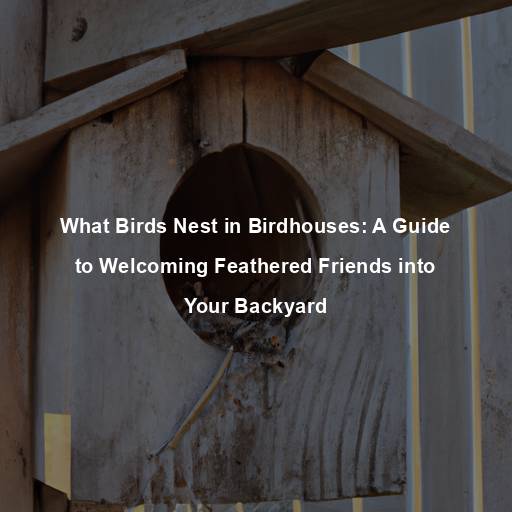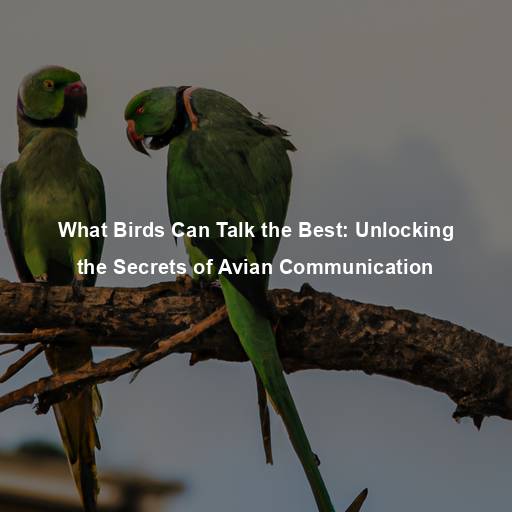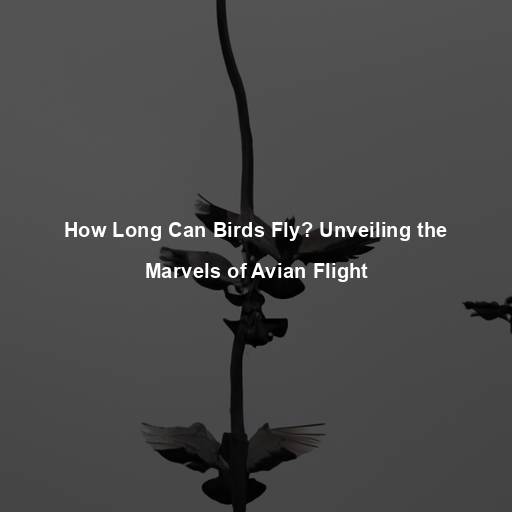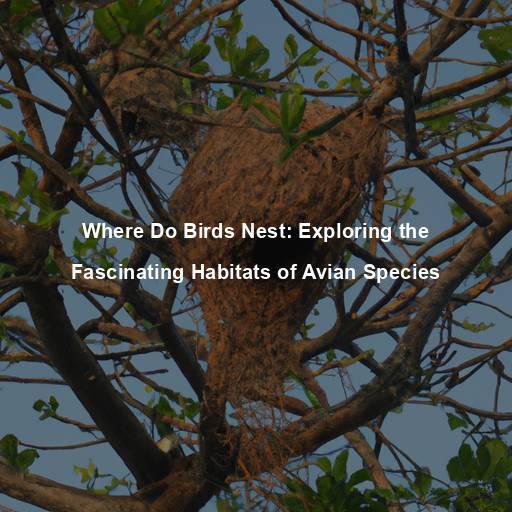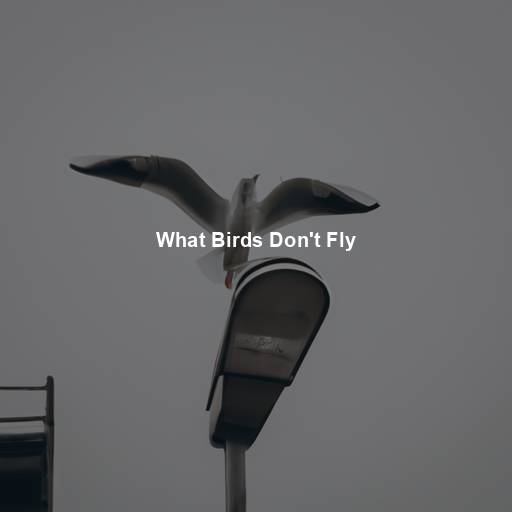What Birds Nest in Birdhouses: A Guide to Welcoming Feathered Friends into Your Backyard
Last Updated on August 5, 2023 by Evan
Birdhouses are not just charming decorations for your backyard; they can also serve as cozy nesting spots for various bird species. Providing a safe and comfortable environment for birds to raise their young is a rewarding experience for any bird enthusiast. But what birds actually nest in birdhouses? In this guide, we will explore the fascinating world of avian homeowners and discover the diverse range of species that might call your birdhouse their home.
Contents [hide]
Understanding Birdhouse Basics
When it comes to attracting feathered friends to nest in your backyard, it’s crucial to consider the essential elements of an ideal nesting spot. Before we dive into the fascinating world of bird species that happily take up residence in birdhouses, it’s important to grasp a few key factors. By keeping these in mind, you’ll be well-prepared to create the perfect avian abode in your own backyard.
House Design and Size
Birdhouses come in various designs, each catering to specific bird species. The size of the entrance hole, the dimensions of the cavity, and the overall house design all play a role in determining which birds will find it appealing. Research the specific requirements for the bird species you hope to attract and choose a birdhouse that meets their needs.
Proper Placement
Birdhouses should be strategically placed to attract nesting birds. Consider the habitat preferences and foraging behaviors of your target species. Some birds prefer houses mounted on poles, while others may prefer hanging or tree-mounted options. Ensure the birdhouse is protected from predators and has adequate shade or sunlight, depending on the species.
Nesting Materials
When it comes to birdhouses, it’s not just about shelter. Birds have their own quirky preferences and love to put their stamp on their new homes. To attract these feathered architects, provide them with a range of nesting materials like twigs, grass, and feathers. By giving them the freedom to decorate, you’ll increase the chances of them selecting your birdhouse as their perfect nesting spot.
Popular Bird Species That Nest in Birdhouses
Now that we understand the basics, let’s explore some of the most common bird species that readily take up residence in birdhouses:
Eastern Bluebirds (Sialia sialis)
Eastern Bluebirds are beloved for their vibrant blue plumage and melodious songs. These cavity-nesting birds are highly sought after by bird enthusiasts. To attract bluebirds, provide a birdhouse with an entrance hole measuring about 1.5 inches in diameter. Place the house in open areas, preferably near fields or meadows.
American Robins (Turdus migratorius)
While American Robins are known for building their nests in trees, they occasionally adopt birdhouses as alternative nesting sites. These larger birds require a spacious birdhouse with an entrance hole measuring around 4 inches in diameter. Mount the house on a sturdy post or attach it to a tree trunk.
Tree Swallows (Tachycineta bicolor)
Tree Swallows are graceful aerial acrobats with iridescent blue-green plumage. These birds are highly sociable and often nest in colonies. To attract Tree Swallows, provide multiple birdhouses in an open area, preferably near water sources. Their ideal house should have a small entrance hole of around 1.5 inches in diameter.
House Wrens (Troglodytes aedon)
House Wrens are tiny birds with big personalities. They are known for their energetic songs and their habit of filling birdhouses with twigs and other materials. To attract House Wrens, choose a birdhouse with a small entrance hole, approximately 1 inch in diameter. Place the house in a dense shrub or tangle of vines.
Purple Martins (Progne subis)
Did you know that Purple Martins are not just your ordinary swallows? They are known for their colossal size and their peculiar preference for human-made habitats. These fascinating creatures have a strong penchant for nesting in communal houses, equipped with numerous cozy compartments. To invite Purple Martins into your neighborhood, consider installing a spacious martin house with a multitude of individual nesting chambers.
Chickadees (Poecile spp.)
Chickadees are small, charming birds known for their distinctive calls and playful nature. They readily adopt birdhouses, especially those with small entrance holes, around 1-1.25 inches in diameter. Place the house near trees or shrubs, as Chickadees enjoy the cover they provide.
House Sparrows (Passer domesticus) and European Starlings (Sturnus vulgaris)
Did you know that House Sparrows and European Starlings, although not originally from North America, sometimes find their way into birdhouses as opportunistic nesters? It’s quite perplexing, really. While they may seem harmless, their aggressive nature towards native birds is something to be concerned about. To protect the well-being of other nesting inhabitants, it might be wise to take some measures to discourage their presence in your birdhouses.
Encouraging Nesting Success
Creating a welcoming haven for our avian companions involves more than just putting up birdhouses. Unlock the secrets to boosting the nesting triumph of these magnificent creatures with these invaluable suggestions:
Water Sources
Providing our enchanting feathered friends with an oasis of refreshment is an absolute necessity, as these exquisite creatures yearn for pure, untainted water to quench their thirst and indulge in their meticulous grooming rituals. Introducing a charming birdbath or a miniature aquatic haven in close proximity serves as an irresistible magnet, beckoning nesting birds to grace our surroundings, for they depend on these liquid gems to satiate their hydration needs and uphold the resplendence of their majestic plumage.
Native Plants and Food Sources
Creating a bird-friendly environment involves planting native trees, shrubs, and flowers that provide natural food sources, such as berries and nectar-rich blooms. Research the plant species native to your region and cultivate a diverse landscape to attract a wider variety of birds.
Predator Protection
Ensuring the survival and well-being of our beloved nesting birds holds utmost importance. These graceful creatures need a safe haven, shielded from the prying eyes and lurking danger of predators. To achieve this, it is imperative to exercise caution when selecting the location for birdhouses – a distance far from feline prowling grounds or other menacing threats. Furthermore, outfitting poles or trees with protective baffles or predator guards acts as a formidable deterrent against climbing predators, granting our feathered friends the serenity they deserve.
Regular Maintenance
As springtime ushers in a symphony of chirps and melodies, it’s vital to embark on a whimsical inspection of your enchanting birdhouses. Embrace the surreal wonder of these miniature avian abodes, delicately unraveling their mysteries. Engage in a ritualistic purification of these dwelling wonders by diligently purging remnants of yesteryear’s nests, warding off the unseen perils that lurk within the shadows. Tread the delicate path of restoration, mending any faltering foundations, and offering these avian havens a renewed sense of allure, beckoning the graceful inhabitants yet to come.
The Joy of Birdhouse Watching
Providing birdhouses in your backyard not only benefits the avian community but also offers you the opportunity to observe their fascinating behaviors up close. From the delicate construction of nests to the first cries of hatchlings, birdhouse watching can be a delightful and educational experience for all ages.
Whether you’re an avid admirer of avian creatures or a budding explorer of the enchanting realm of birdwatching, the art of establishing birdhouses can prove to be a delightful means of inviting a diverse range of winged wonders and playing a part in their preservation endeavors. By fashioning a hospitable haven for our befeathered companions, brace yourself for the magnificent spectacle of nature unfurling its mesmerizing tapestry right at your doorstep.
Note: Remember to check local regulations and guidelines regarding the placement of birdhouses, as well as any specific recommendations for the bird species in your region.## Attracting Specific Bird Species: Tips and Tricks
When it comes to nesting, each bird species has its own set of preferences and requirements that can leave you scratching your head in perplexity. But fear not, for we’ve compiled a list of tips and tricks to help you attract that particular avian friend you have in mind. So get ready to embark on a burst of knowledge as we unravel the secrets to increasing your chances of nesting success.
Attracting Woodpeckers
Woodpeckers can be fascinating birds to observe with their distinctive drumming and pecking behaviors. To attract woodpeckers to your birdhouse, choose a design specifically tailored for their needs. Woodpecker birdhouses often have a larger entrance hole, around 2-2.5 inches in diameter, and a sturdy construction to withstand their powerful pecking. Place the house on a tree trunk or post in a wooded area, as these birds prefer nesting in mature trees.
Welcoming Owls
Owls, those mysterious creatures of the night, fascinate and mystify us with their elusive nature. If you long to experience the rare joy of spotting these majestic birds in your very own backyard, why not consider the installation of an owl nesting box? These specialized abodes, purposefully built to cater to the unique needs of owls, serve as a beacon of hope for hosting these enigmatic avian creatures. However, it is of utmost importance to conduct thorough research on the diverse owl species that inhabit your particular region, as this knowledge will guide the selection of a suitable box design and a strategically elevated mounting location, ensuring an optimal sanctuary for these captivating creatures.
Encouraging Hummingbirds
Ever been captivated by the allure of delicate, vibrant hummingbirds? Their mesmerizing iridescent feathers and lightning-fast wingbeats have a way of stealing our hearts. Want to invite these tiny enchanters into your own backyard? It’s all about creating their own little oasis – a welcoming sanctuary where they can indulge in a sugar-water feast from a hummingbird feeder.
Luring Nuthatches and Titmice
In the whimsical world of avian wonders, nuthatches and titmice soar into the spotlight with their nimble. Their enchanting acrobatics and relentless pursuit of insects and seeds make them the ultimate performers of the bird kingdom. To lure these delightful creatures into your feathered haven, opt for a birdhouse design that boasts a petite entrance hole, measuring approximately 1-1.25 inches in diameter. Embrace the mystical vibes of nature’s embrace by mounting this avian oasis on a majestic tree trunk or sturdy post within a woodland oasis, for these birds revel in the allure of natural cavities.
Hosting Purple Finches
The Purple Finch, with its vibrant color and angelic tunes, adds a touch of enchantment to any avian ensemble. These delightful creatures display a penchant for nesting in the verdant embrace of shrubs and trees, although they may occasionally take up residence in carefully selected birdhouses. To catch their attention, opt for a cozy abode with a petite entrance, approximately 1.25 inches in diameter. Delicately position the dwelling in a tranquil, shaded realm, mirroring the ambience of their preferred nesting domains.
Observing Nesting Behaviors
As the days grow longer and nature comes alive, the humble birdhouse becomes a stage where avian dramas unfold. Intrigued by the flutter of wings and the songs that fill the air, we can bear witness to the captivating behaviors of nesting birds. From intricate courtship rituals to tireless construction efforts, these feathered protagonists bring bursts of life and perplexity to our backyards. So, grab your binoculars and embark on a journey into the enchanting world of avian parenthood.
Nest Building
Birds exhibit impressive architectural skills when constructing their nests. They diligently gather materials, such as twigs, grass, feathers, and moss, to create a sturdy and comfortable home for their eggs and hatchlings. You might observe birds meticulously arranging each twig or delicately weaving fine strands of grass to form the nest’s structure.
Egg Laying
Birds, those majestic creatures of the sky, have a methodical yet unpredictable approach to their egg-laying rituals. Once the intricate nest is ready, females embark on their remarkable journey of creating life, often laying eggs one by one, like an enchanting daily surprise. The number of eggs is as diverse as the wings that grace our planet, from the solitary owl with its solitary egg, to the waterfowl that dazzles us with its magnanimous clutch, bouncing between dozens of eggs. Studying the intricacies of these egg-laying patterns holds the key to understanding the enigmatic nature of avian reproduction, offering us a glimpse into their mysterious world.
Incubation Period
Witness the awe-inspiring ritual of avian parenthood, as devoted feathered companions expertly share the responsibility of nurturing their precious offspring. Behold the mesmerizing sight of a vigilant parent, delicately tending to the nest, meticulously maintaining the perfect environmental conditions required for the delicate miracles unfolding within. Time becomes a fluid concept as moments turn into weeks, the duration of this captivating process enigmatic, influenced by the unique characteristics of each avian species.
Hatching and Nestling Care
One of the most exciting moments in birdwatching is witnessing the hatching of the eggs. Tiny, vulnerable hatchlings emerge from their shells, relying entirely on their parents for food, warmth, and protection. You might observe the parent birds making frequent trips to the nest, delivering insects, seeds, or regurgitated food to nourish their growing offspring.
Fledging and Independent Life
As the young birds undergo the miraculous transformation of growing their flight feathers, they reach a pivotal moment in their lives: the time to leave the safety of their nest. Witness the awe-inspiring spectacle as they take their tentative first flights, venturing into the vast unknown while gaining courage with each passing moment. Stay alert for the wondrous sight of these fledglings as they navigate through their environment, gradually overcoming their trepidation and embracing the exhilaration of being airborne.
The Rewards of Birdhouse Ownership
Owning and maintaining birdhouses can be a deeply fulfilling experience. Not only do you provide valuable nesting opportunities for birds, but you also gain insight into their intricate lives and behaviors. The joy of observing birds as they build their nests, care for their young, and take flight for the first time is immeasurable.
Creating a nurturing environment for our feathered friends is no small feat. By tailoring birdhouses and resources to meet the unique needs of different bird species, we can make a real impact on avian conservation. Transforming our own backyards into bird sanctuaries is a powerful way to support the breeding success and long-term survival of these captivating creatures. Together, let’s embark on this perplexing yet fulfilling journey, and ensure that future generations will marvel at the vibrant diversity of our avian neighbors.
So, gather your tools, select the perfect birdhouse designs, and embark on an exciting journey of attracting and nurturing the feathered residents of your neighborhood. Immerse yourself in the wonders of nature as you welcome these avian neighbors into your backyard, and let the beauty of their songs and vibrant plumage fill your days with joy and inspiration.
FAQs for the topic: What birds nest in birdhouses?
Which birds typically nest in birdhouses?
The enchanting world of birdhouses unveils a captivating truth – their purpose is far beyond mere decor. These wooden sanctuaries serve as havens for cavity-nesting birds, the kind that possess an innate longing for hollow havens to nurture their young. From the majestic bluebirds to the charming wrens, the industrious chickadees to the delightful titmice, the resourceful nuthatches to the diverse array of woodpeckers, these avian beings have ingeniously embraced man-made dwellings as an alternative to vanishing tree cavities in the face of habitat destruction and tree extraction. A harmonious blend of nature and human intervention, these precious birdhouses breathe life into the perplexing dance of survival in the ever-changing tapestry of our environment.
How do birds choose a nest site in a birdhouse?
Birds evaluate potential nest sites based on certain criteria. The size and shape of the birdhouse entrance hole are important factors, as they determine which bird species can comfortably enter. Different species prefer specific entrance sizes to reduce the risk of predation and competition with larger birds. The location and mounting height of the birdhouse are also important considerations, as birds prefer secluded spots away from predators and at heights that suit their nesting habits. Proper protection from the weather, such as a slanted roof and good ventilation, also contribute to the appeal of a birdhouse as a suitable nest site.
How can I attract specific bird species to nest in my birdhouse?
To attract specific bird species, it is essential to provide the preferred nesting conditions for each species. Research the nesting habits of the birds you wish to attract and select a birdhouse with appropriate specifications, including the right entrance hole size and shape. Placing appropriate nesting materials near the birdhouse, such as twigs, leaves, or grasses, can also attract nesting birds. Moreover, creating a bird-friendly environment by offering a variety of food sources, fresh water, and appropriate vegetation will increase the chances of attracting the desired bird species to nest in your birdhouse.
How can I ensure the safety and success of nesting birds in a birdhouse?
Creating a safe haven for nesting birds requires diligent upkeep and attentive monitoring. To safeguard their welfare, it is essential to periodically tidy the birdhouse, removing any debris or remnants from previous nesting seasons. This proactive measure acts as a deterrent against the transmission of diseases or the invasion of parasites. When possible, consider adding a protective barrier, such as a sturdy metal plate or a shrewdly designed cone, to thwart intrusions from squirrels, raccoons, slithering snakes, or any other potential predator. Remember, during the nesting season, it is crucial to limit disturbances and reduce stress for our avian residents. By adopting a more discreet approach, binoculars become indispensable tools for observing their magnificent nature up close, while still ensuring their peace and tranquility.
What should I do if a birdhouse remains unoccupied?
When it comes to birdhouses, ensuring occupancy can be quite the challenge. Various factors come into play – the location, height, entrance hole size, and surrounding environment all play a role in enticing our feathered friends to take up residence. It’s crucial to align these factors with the nesting requirements of the specific bird species you’re hoping to attract. Additionally, offering more attractive nesting materials nearby or repositioning the birdhouse within your property could make it more appealing. But remember, it may take some time for the birds to discover and explore the new housing option, so patience is key in this pursuit.

